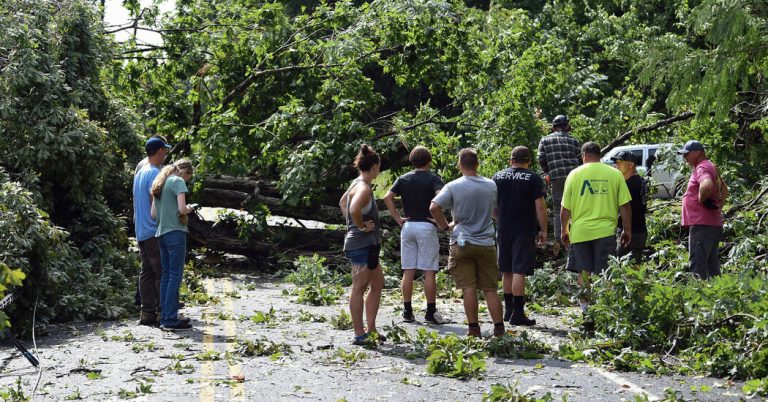A “complex and active” storm system swept through the eastern United States on Monday evening, producing widespread thunderstorms that killed at least two people, grounded thousands of flights and left more than a million homes and businesses without power.
The line of storms stretched from Georgia to New York, downing power lines, crashing trees into homes and ripping off roofs on buildings, according to preliminary reports from the National Weather Service.
The Federal Aviation Administration ordered airports to cancel flights along a busy travel corridor linking major US cities, including Atlanta, New York and Washington, delaying or canceling thousands of flights.
At least one tornado was confirmed, just after 5:30 p.m., in the village of McGraw, about 30 miles south of Syracuse, New York, but it caused minor damage, McGraw Mayor Alan Stober said Tuesday afternoon. He noted that tree limbs had fallen, but he had not received any reports of major structural damage. A local television station reported that the roof of one of the buildings had been destroyed.
In Florence, Alabama, a 28-year-old man died after being struck by lightning in a city parking lot, about 60 miles west of Huntsville, local police said. In Anderson, South Carolina, a 15-year-old boy was killed when a large tree fell and injured him, according to local fire officials.
In Pennsylvania, a person was injured when a tree fell on the car he was traveling in, according to initial reports. In Virginia, officials rescued a woman who was trapped inside her home after a tree fell on it.
Some of the hardest-hit areas were along the Mason-Dixon line and southern Appalachia, said David Roth, a meteorologist with the National Weather Service.
He warned that although a line of storms, known as a bow echo, is moving off the New Jersey coast, there is still a risk of heavy rain overnight into Tuesday in parts of upstate New York and Vermont. He added that “heavy rain may have just started,” noting that the area can expect several inches.
In Cambridge, Maryland, several inches of rain caused flash flooding that left more than a dozen people stranded in their cars on flooded roads, Cambridge Police Department Chief Justin Todd wrote via email. He added that no injuries or deaths had been reported, noting that several streets were closed while police were working with local officials to remove rubble from the roads.
While the waters were receding, “several roads” remained flooded, Dorchester County Councilman Rob Kramer Jr. said.
As of early Tuesday, nearly 400,000 homes and businesses from Georgia to Pennsylvania remained without power, according to poweroutage.us.
Scientists say climate change has led to an increase in storm surges in recent years, making hurricanes more intense and heavy rainfall more frequent. Droughts, floods, wildfires and heat waves are becoming increasing threats.
Where heavy rainfall is a concern, so is the risk of catastrophic flooding. But higher temperatures make the problem worse: They allow the air to hold more moisture, leading to more intense and sudden rainfall.
Jesus Jimenez, Lauren McCarthy , Derek Bryson Taylor Rebecca Carballo contributed reporting.

